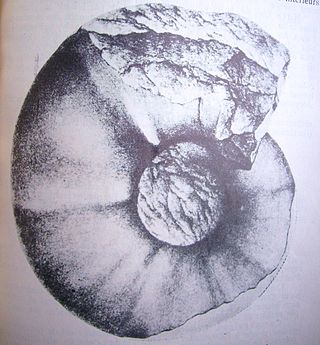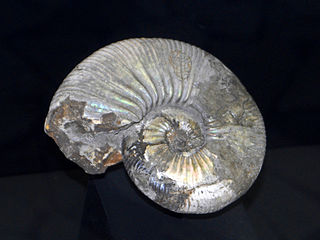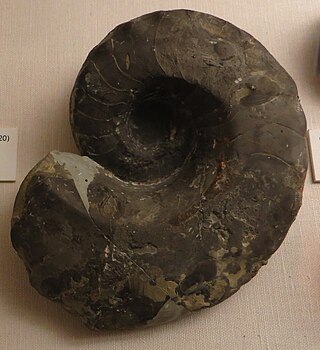
Abrytasites (Abrytusites) is an extinct genus of cephalopods belonging to the Ammonoidea subclass.

Acanthohoplites is an extinct genus of ammonites in the family Parahoplitidae that lived in the Aptian and Early Albian stages of the Early Cretaceous.

Ancyloceras is an extinct genus of heteromorph ammonites found throughout the world during the Lower Cretaceous, from the Lower Barremian epoch until the genus extinction during the Lower Aptian.
Asapholytoceras is a lytoceratid ammonite, originally from the upper Lower Jurassic of southeastern Europe with high, compressed whorls and a sharp angle to the umbilical shoulder. The exposed suture has four primary lobes on either side; the internal dorsal lobe is not cruciform.

Arcticoceras is an extinct ammonoid cephalopod genus from the late Middle Jurassic belonging to the ammonite family Cardioceratidae, more commonly found to high northern latitudes.
Arctocephalites is an extinct ammonitic cephalopod genus from the Middle Jurassic with a wide northern distribution belonging to the stephanoceratacean family, Cardioceratidae.
Balearites is an extinct ancyloceratin genus included in the family Crioceratitidae, subclass Ammonoidea, from the Upper Hauterivian.

Barremites is an ammonoid cephalopod genus belonging to the family Desmoceratidae, that lived during the Hauterivian and Barremian stages of the Early Cretaceous.
Sholakoceras is an extinct genus of nautiloid cephalopods from the Lower Permian of southern Russia, included in the Tainoceratacean family Rhiphaeoceratidae,. The shell of Shalakoceras is evolute with a perforate umbilicus. Whorl sections are subquadrate with the ventral and lateral sides flattened and ventral and umbilical shoulders rounded. Lateral areas bear short, slightly oblique ribs. sutures form broad ventral saddles with a slight, shallow lobe, very shallow lateral lobes, and a deep funnel-shaped dorsal lobe.
Permoceras, the sole member of the family Permoceratidae, is a genus of coiled nautiloids with a smooth, compressed involute shell, whorls higher than wide, earlier whorls hidden from view. The venter is rounded as are the ventral and umbilical shoulders, the flanks flattened. The siphuncle is ventrally subcentral. The suture, which is most characteristic, has a deep, narrow pointed ventral lobe and large, asymmetrical pointed lobes on either side.
Heminautilus is an extinct genus of nautiloids from the nautilacean family Cenoceratidae that lived during the Early Cretaceous. Fossils of Heminautilus have been registered in rocks of Barremian and Aptian age. Nautiloids are a subclass of shelled cephalopods that were once diverse and numerous but are now represented by only a handful of species.
Biloclymenia is a genus in the ammonoid order Clymeniida which is characterized by a dorsal retrosiphonitic siphuncle with long adapically pointing septal necks.
Bochianites is a straight shelled ammonite which lived from the Upper Jurassic, Tithonian, to the Lower Cretaceous, Hauterivian in what is now Europe, Greenland, Africa, North America and Asia. The shell is long, narrow, moderately expanding; smooth or with weak to strong oblique annular ribs. Sutural elements are short and boxy. The umbilical lobe, which lies between the lateral lobe and dorsal lobe, on either side, is about the same size as the lobule dividing the first lateral saddle.
Falcitornoceras is a goniatitid ammonite from the Late Devonian, early Famennian, that has been found in France and Spain. Falcitornoceras was named by House and Price, 1985, and is the type genus for the subfamily Falcitornoceratinae.

Barremitinae is a subfamily belonging to the Ammonoidea subclass.

Germanonautilus is a cephalopod genus included in the nautilid family Tainoceratidae, found widespread in the Triassic of North America, Europe, Asia, and north Africa. The shell is a moderately involute nautilicone ; whorl section subquadrate to trapezoidal, widest across the umbilical shoulders, flanks flattened and ventrally convergent, venter flat and wide, dorsum narrowly and deeply impressed. The suture is with broad and deep lateral lobes and a shallow ventral lobe. The siphuncle is central and nummuloidal, composed of expanded segments that give a beaded appearance.

Lytoceratinae is a subfamily of ammonoid cephalopods that make up part of the family Lytoceratidae.

Monophyllites is an extinct cephalopod genus belonging to the family Ussuritidae that lived during the Triassic period, from Anisian to Ladinian age.

Hemihoplites is an extinct genus of ammonoid cephalopods belonging to the family Hemihoplitidae. These fast-moving nektonic carnivores lived in the Cretaceous period, from the Hauterivian age to the Barremian age.
Radstockiceras is an extinct genus of lower Jurassic ammonite that lived from Oxynotum zone of upper Sinemurian to Raricostatum zone of lower Pliensbachian. Shells of these animals were oxycone and involute with umbilicus that took maximum of 12% of diameter in the case of outer whorls. On inner whorls, venter has been sharp, but then it became rounded. Faint ribs had falcoid shape, but sometimes, ribs could absent. Shells could have been large in their size. Suture has been very complex, similar to Oxynoticeras, but culmination at umbilical margin has been missing. Genus has been named after town of Radstock, in Somerset.









